Hoodie vs Sweatshirt: Compare Fabric, Material And Specifications
Many people own both hoodies and sweatshirts because they are popular casual clothing items. They are often chosen for comfort and warmth, but each has distinct features that affect how they look and feel. Understanding these differences can help people pick the right one for their style and needs.
The key difference between a hoodie and a sweatshirt is that a hoodie has a hood, which adds extra warmth and style options, while a sweatshirt typically does not. This guide will help readers learn how to choose between the two based on design, comfort, and use.
Table of Contents
1) Definition and Key Features of Hoodies
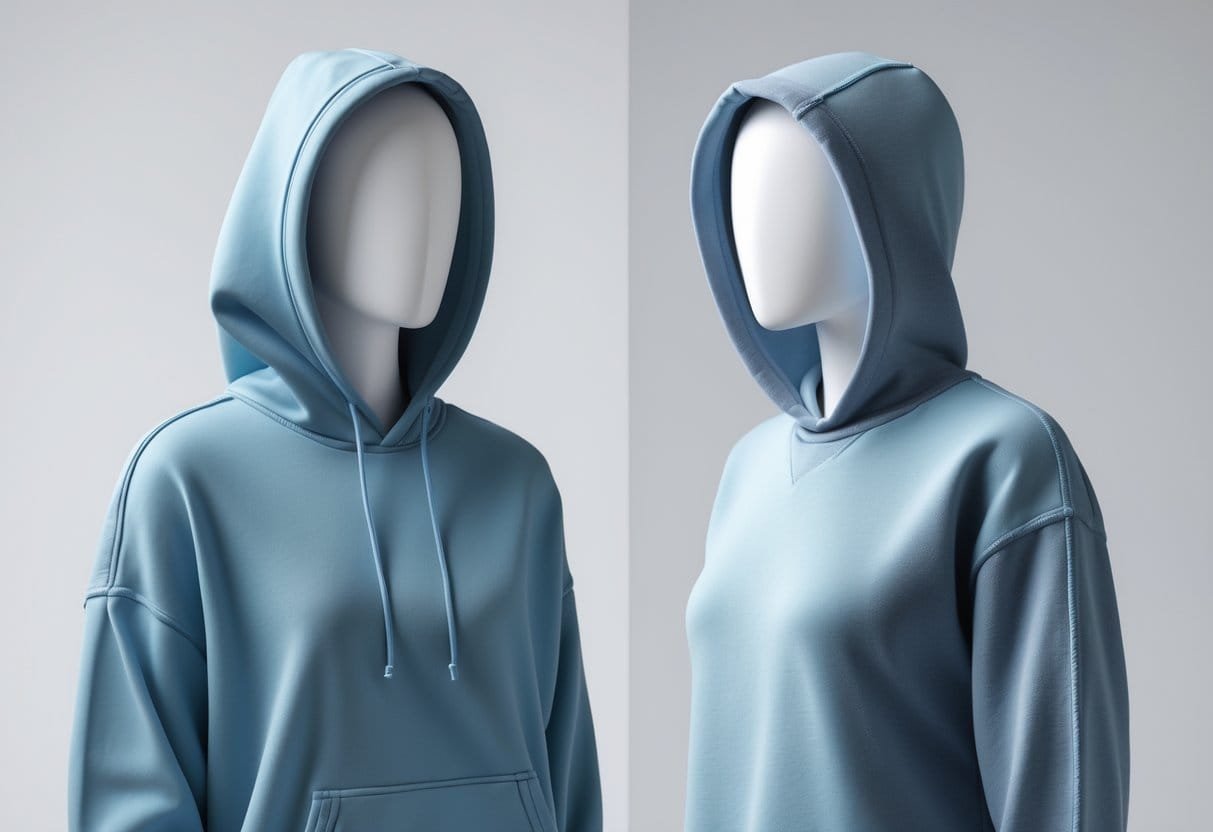
A hoodie is a type of sweatshirt that includes a hood attached to the back. It often has a drawstring to adjust the hood’s fit. This design adds extra warmth and protection against wind or rain.
Most hoodies also feature a front pocket, commonly called a kangaroo pocket. This pocket helps keep hands warm and provides space for small items. Some hoodies may include a zipper down the front, allowing easy on and off.
Hoodies are usually made from thicker materials like cotton or fleece. This helps keep the wearer cozy in colder weather. Because of these features, hoodies are often preferred for casual, comfortable outfits and activewear.
In summary, the hood, drawstring, front pocket, and thicker fabric are key features that set hoodies apart from other casual tops like sweatshirts.
2) Definition and Key Features of Sweatshirts
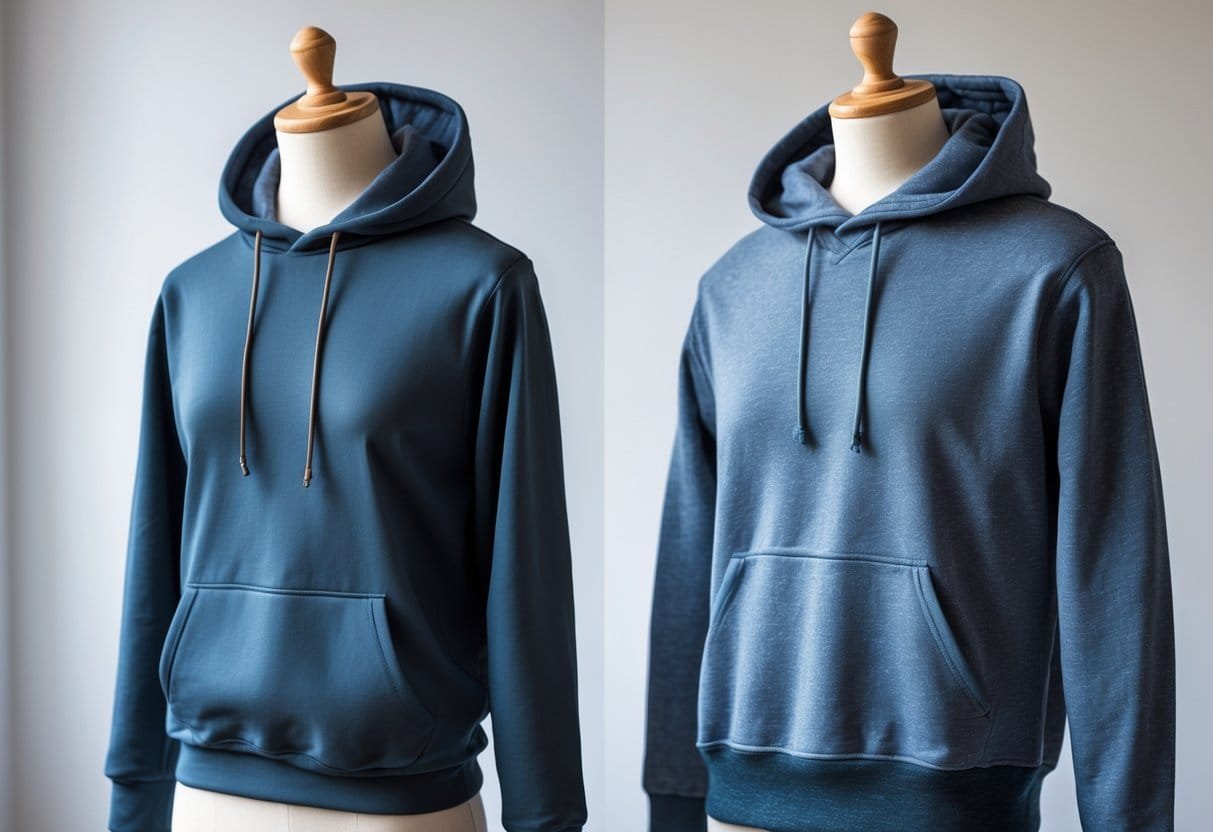
A sweatshirt is a long-sleeved pullover made from thick cotton or a cotton-blend fabric. It is designed to provide warmth and comfort, making it a popular choice for casual and everyday wear. Unlike hoodies, sweatshirts do not have a hood.
They often feature a crew neck, which means the neckline is round and collarless. Sweatshirts may have ribbed cuffs and hems to help keep the warmth in. Their simple design makes them versatile and easy to layer with other clothing.
Sweatshirts are usually lighter than hoodies but still offer good insulation. They are often worn for sports, lounging, or casual outings. Some sweatshirts come with minimal or no pockets, focusing more on a clean and sleek look.
Overall, sweatshirts are known for their adaptability and classic style. They are less tied to any specific fashion trend and more focused on comfort and function.
3) Material Differences Between Hoodies and Sweatshirts
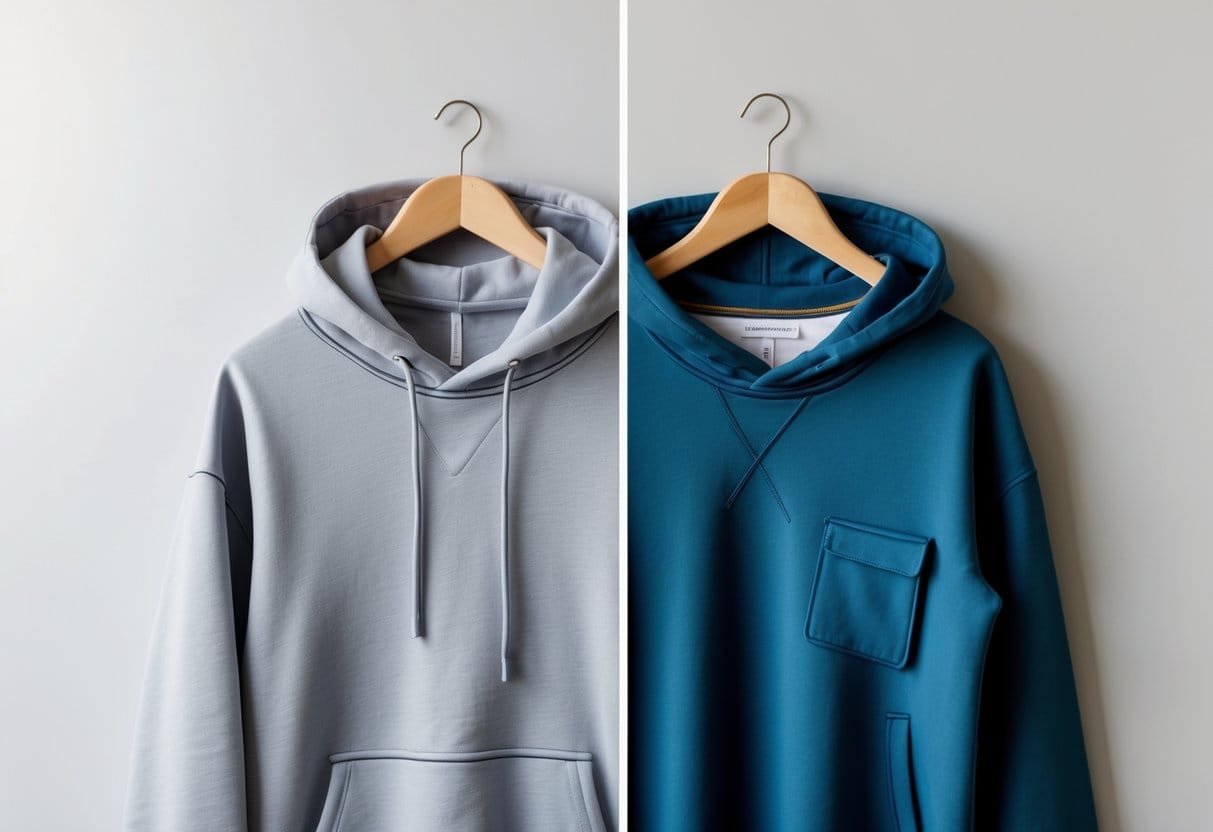
Hoodies and sweatshirts are usually made from cotton, polyester, or a blend of both. Hoodies often use thicker, fleece-lined fabric to provide extra warmth. This helps keep the wearer comfortable in cooler weather.
Sweatshirts tend to be lighter and use smoother fabric. The material is soft but does not always have the same insulation as a hoodie. Because of this, sweatshirts work well for mild temperatures or indoor wear.
The design of hoodies also adds to their warmth. The hood and sometimes front pockets are made with the same thick fabric, increasing coverage. Sweatshirts usually lack these features, focusing on a simpler, flat design.
Both garments come in many colors and fabric mixes. However, hoodies often offer a wider range of vibrant options. The material choice depends on the intended use, such as layering or casual wear.
In short, hoodies usually have heavier fabric for warmth, while sweatshirts use lighter material for comfort and ease of movement.
4) Styling Hoodies for Athleisure Looks
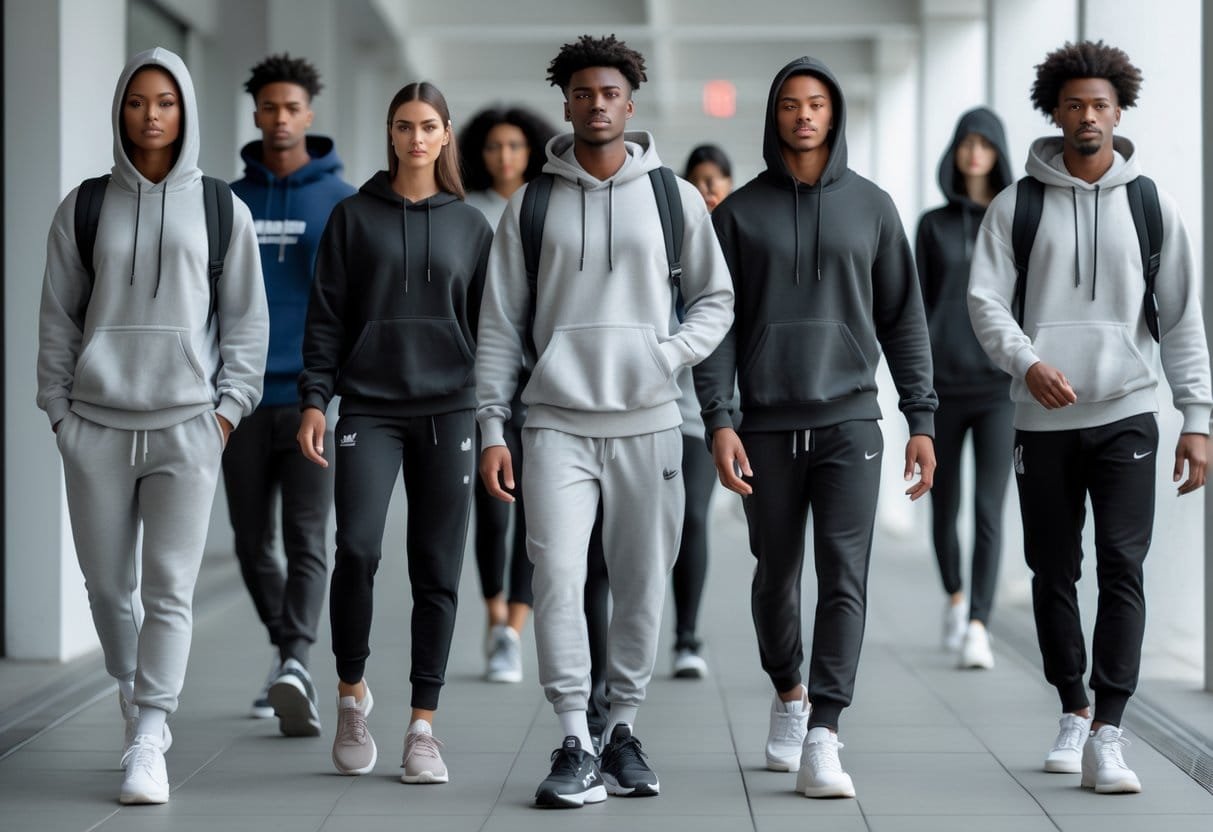
Hoodies are a key piece for creating athleisure outfits. They offer comfort and style in one simple garment. Pairing a hoodie with joggers or fitted sweatpants makes a good, relaxed look that works well for casual outings or workouts.
To add more style, layering a hoodie under a leather or denim jacket can give a smart-casual edge. Sneakers are an important part of the athleisure style, completing the outfit with a sporty touch.
For a fresh twist, combining a cropped hoodie with high-waisted leggings or shorts creates a balanced, fashionable look. Rolling up the sleeves or tucking in the front of the hoodie can add subtle polish.
Accessories like a baseball cap or a simple backpack fit well with the athleisure vibe. These small details help keep the look interesting without being too busy.
This style is easy to wear every day. It blends function and fashion for those who want casual but put-together clothes. Hoodies stand out because they feel good to wear and look good with simple pieces.
5) Pairing Sweatshirts with Denim for Casual Wear

Sweatshirts and denim create a simple and comfortable look. Classic blue jeans work well with sweatshirts, giving a timeless casual feel. Black or distressed denim can add a modern edge to the outfit.
The key is balancing the fit and style. A slim or straight fit jean pairs nicely with a slightly oversized sweatshirt for a relaxed look. For a more fitted sweatshirt, looser denim can offer contrast.
Layering can improve the outfit’s depth. Adding a light jacket over the sweatshirt, such as a denim or bomber jacket, brings warmth and style. Footwear like sneakers or casual boots finishes the outfit.
Colors matter when pairing sweatshirts with denim. Neutral tones like gray, black, and white are easy to match. Bright or pastel sweatshirts can add a pop of color while keeping the outfit casual.
Simple accessories such as hats or watches can enhance the look without making it busy. This pairing suits many occasions, from running errands to meeting friends.
6) Warmth and Insulation Comparison
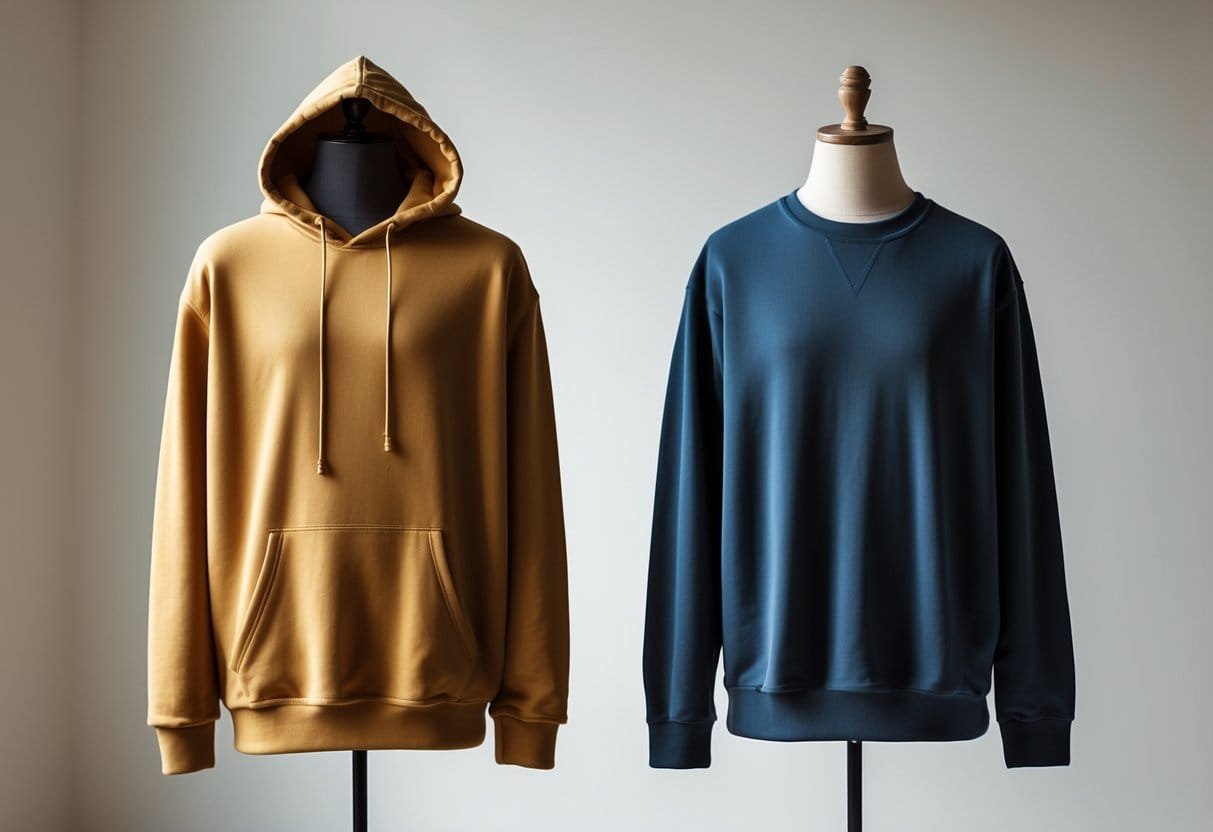
Hoodies usually provide more warmth than sweatshirts. This is mainly because hoodies have a hood, which helps protect the head and neck from cold and wind. The added coverage increases their insulation.
Both hoodies and sweatshirts are made from similar materials like cotton or fleece, which offer comfort and warmth. However, the design difference gives hoodies a slight edge for cold weather.
Sweatshirts tend to have a simpler design without a hood, making them lighter but less protective in very cold or windy conditions. They work well indoors or for mild weather when extra head coverage is not needed.
When it comes to insulation, both can vary depending on thickness and fabric quality. Thicker sweatshirts or hoodies with fleece lining trap more heat. Choosing one depends on whether warmth or style is the priority.
7) Use Cases: Outdoor Activities vs Indoor Comfort

Hoodies are often chosen for outdoor use. They come with a hood and drawstrings, which help protect against wind and light rain. This makes them practical for activities like walking, sports, or running errands in cooler weather.
Sweatshirts, on the other hand, are simpler and more lightweight. They do not have hoods or front pockets, which makes them easy to layer under jackets. People often prefer sweatshirts for indoor use or casual settings where extra warmth and bulkiness are not needed.
For outdoor activities, hoodies offer better protection and comfort. The hood can be pulled up to shield the head without needing extra gear. Sweatshirts focus on comfort and flexibility indoors or as a base layer outside.
Each serves different needs. Hoodies work well in cold, windy conditions, while sweatshirts fit better in mild weather or indoor environments. Users can pick one based on their lifestyle and temperature preferences.
8) Fashion Versatility of Sweatshirts
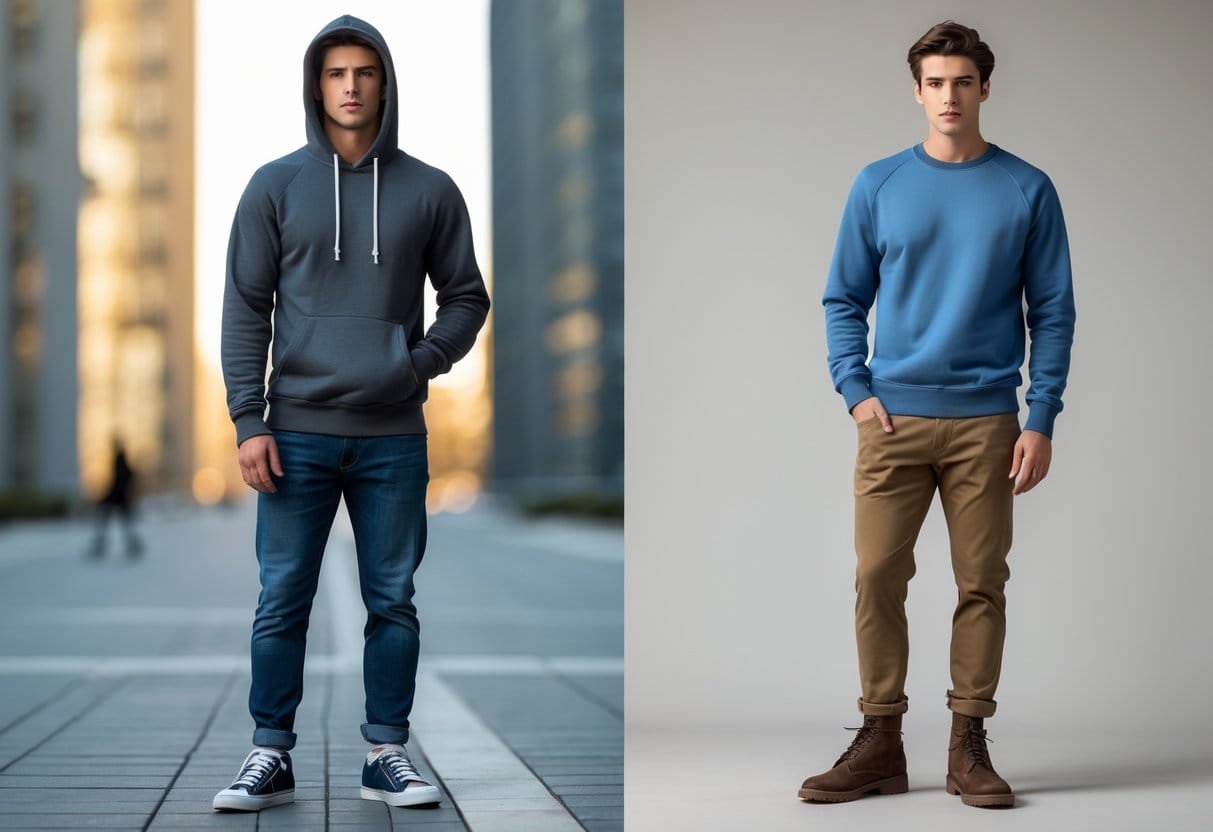
Sweatshirts are known for their simple and clean design, which makes them easy to pair with many outfits. They work well with jeans, shorts, or casual pants, creating a neat and comfortable look. This minimal style allows wearers to dress up or down depending on the occasion.
They can fit various settings, from running errands to casual meetups. Many people layer sweatshirts under jackets or coats in colder weather for added warmth without bulk. Their solid colors and minimal details make them a good base for accessories like scarves or hats.
Sweatshirts also adapt well to different style trends. They can appear sporty when matched with sneakers or take on a more polished look when paired with tailored pants or skirts. This flexibility helps sweatshirts remain a popular choice year-round.
In short, the sweatshirt’s straightforward design and comfort give it broad appeal and style options. It suits those who want an easy, versatile piece without extra features like hoods or pockets.
9) Hoodies for Streetwear and Trendy Outfits
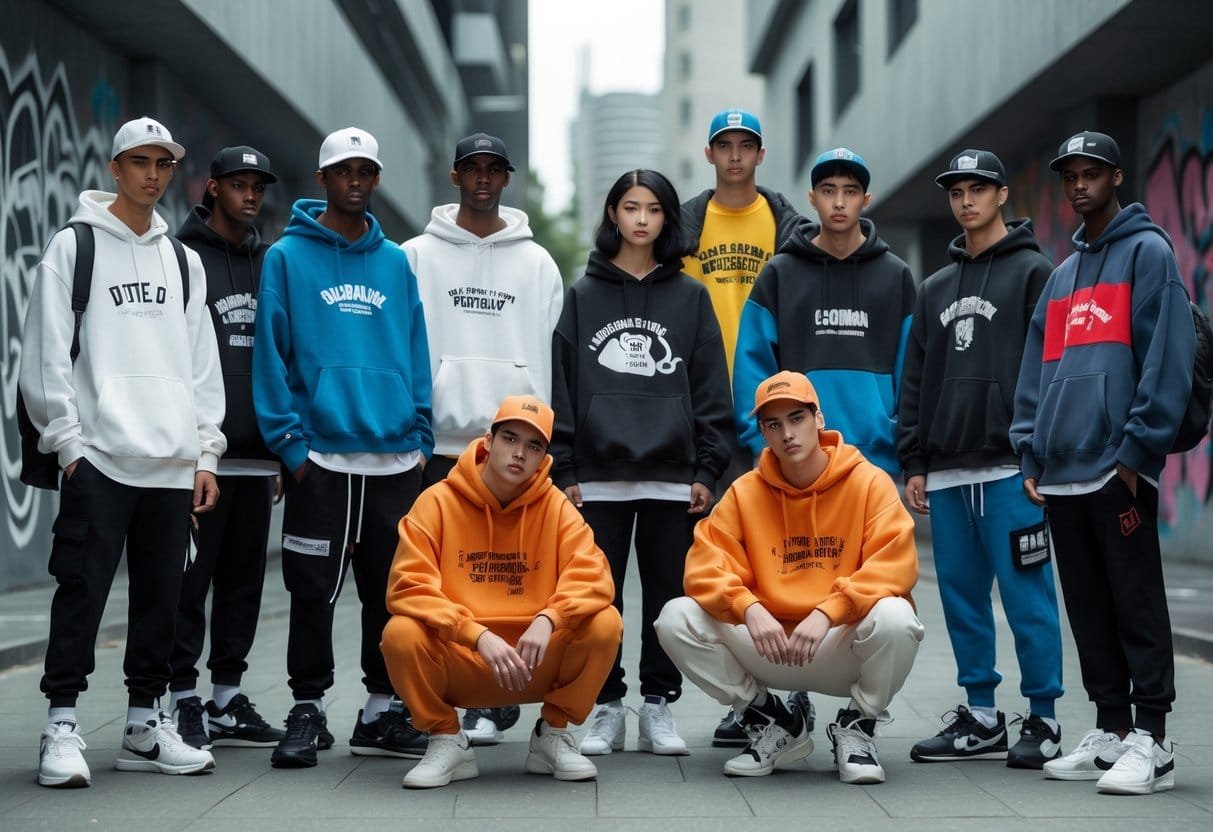
Hoodies are a staple in streetwear fashion. Their casual yet bold look fits well with the urban style many young people prefer. The attached hood adds a unique edge that sweatshirts lack, making hoodies more versatile for weather and style.
They often come oversized, creating a relaxed and modern silhouette. People pair hoodies with joggers, cargo pants, or loose jeans to complete the streetwear vibe. Layering a hoodie under a jacket or over a graphic tee adds depth to the outfit.
Hoodies work well with sneakers and caps, reinforcing the sporty, casual aesthetic. Many brands use hoodies as a canvas for logos or bold designs, making them statement pieces in trendy wardrobes.
In 2025, hoodies remain popular for their comfort and ability to blend practicality with fashion trends. They offer a balance of warmth and style, especially in cooler weather or casual settings. Hoodies are a go-to choice for those looking to stay on trend without sacrificing comfort.
10) Fit and Size Differences to Consider
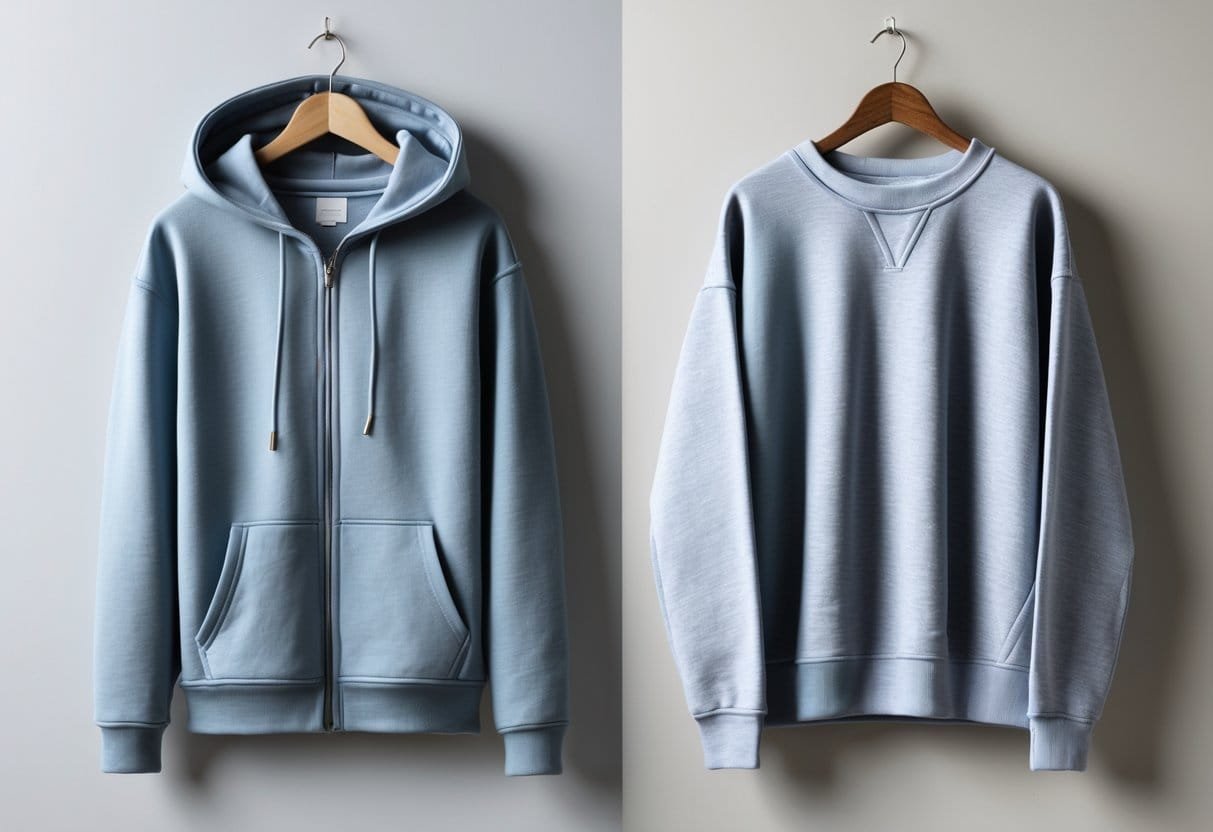
Hoodies and sweatshirts usually have a similar fit, but small differences can affect comfort and style. Hoodies often have a slightly roomier fit to accommodate the hood and pockets. This extra space can make them feel bulkier, especially when layering clothes underneath.
Sweatshirts tend to have a cleaner, more fitted look. They are generally lighter and less bulky because they lack the hood and extra pockets. This can make sweatshirts a better choice for those who prefer a slimmer silhouette or want to wear them under jackets.
When choosing size, measuring chest width and sleeve length is important. If someone likes a looser fit or plans to layer, picking one size larger is a safe bet. Hoodies especially benefit from this as the design naturally adds volume.
Both sweatshirts and hoodies come in different cuts and styles, so shoppers should check brand size charts carefully. A good fit helps avoid discomfort and ensures the garment looks right for casual or streetwear outfits.
Key Differences Between Hoodies and Sweatshirts
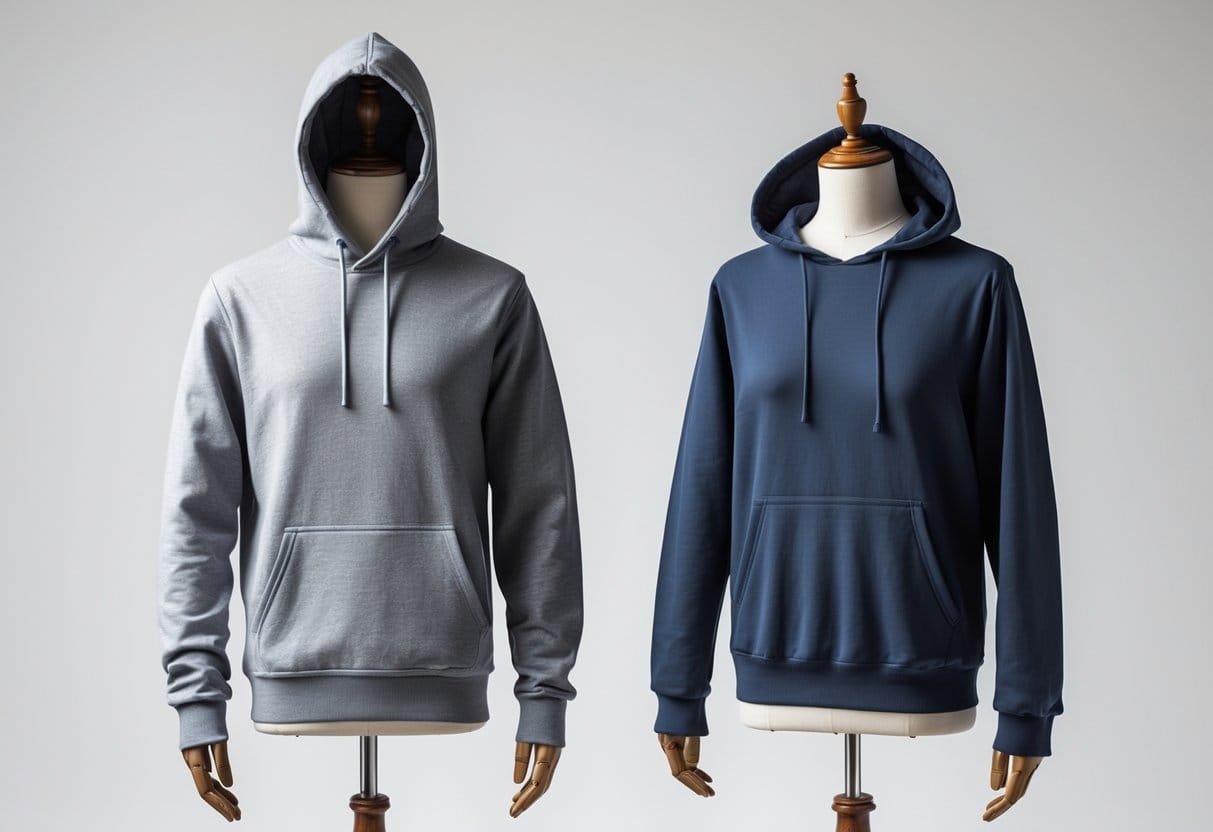
Hoodies and sweatshirts share a focus on comfort and warmth but differ in their materials, design, and how they are used. Each garment offers unique features that suit different needs and occasions.
Material and Construction
Both hoodies and sweatshirts are typically made from cotton blends, often mixed with polyester or fleece, designed for warmth and softness. Sweatshirts usually have a smoother fabric finish, with a tighter knit. This makes them slightly lighter and simpler in feel.
Hoodies often use thicker materials to support extra features like the hood and front pockets. The inner lining of hoodies can be fleece or brushed fabric for added insulation. Sturdier stitching is common on hoodies to hold the hood and cuffs in place.
The material choice impacts weight and breathability. Sweatshirts provide easy layering with moderate warmth, while hoodies offer more protection in cooler or windy weather.
Design and Features
Design is the clearest difference. Sweatshirts are collarless pullovers with no hood or front openings. Their look is plain, focusing on straightforward comfort without extras.
Hoodies include a sewn-in hood, often with adjustable drawstrings. Many have a kangaroo pocket in the front for hand warming or small storage. Some hoodies use zippers instead of being pullovers, adding versatility.
The hood adds protection against wind or light rain. These features make hoodies more functional in outdoor or active settings. Sweatshirts are simpler and more traditional in design.
Intended Use and Versatility
Sweatshirts are often worn indoors or layered under jackets. They fit well for casual, everyday settings or light exercise. Their simple design makes them easy to pair with many styles.
Hoodies serve a broader range of activities, including outdoor workouts and casual streetwear. The hood and pocket add function for weather protection and convenience.
In terms of style, hoodies offer a sporty, youthful vibe. Sweatshirts lean toward classic, minimal looks. Choice depends on the wearer’s lifestyle and preferred level of functionality.
How to Choose the Right Option for Your Style

Choosing between a hoodie and a sweatshirt depends on factors like weather, outfit choices, and where the clothing will be worn. Each has strengths that fit different needs, styles, and occasions.
Seasonal Considerations for Hoodie vs Sweatshirt
For colder months, hoodies often offer more warmth because of their thicker fabrics and the extra coverage from the hood. The hood also adds protection against wind and light rain, making it practical in fall and winter. In milder weather, sweatshirts are a good choice. They provide warmth without the bulk of a hood, which can feel less restrictive and cooler indoors.
Breathability matters too. Sweatshirts tend to have lighter fabrics, so they can be worn comfortably in spring and early fall. Hoodies, particularly those with fleece lining, might be too warm during these seasons. Picking the right material based on temperature will help balance comfort and functionality.
Pairing With Outfits
Hoodies suit casual, streetwear, and sporty looks. They work well with jeans, joggers, or layered under jackets. The hood adds a relaxed vibe, so pairing it with structured pieces like blazers is less common but possible for a layered street style.
Sweatshirts are more versatile for layering and styling. They can be tucked into skirts or worn over collared shirts for a semi-casual look. Their simpler neckline fits better under coats and over shirts. Sweatshirts are easier to style if someone wants a clean, understated appearance without the hood’s casual element.
Occasion Suitability Hoodie vs Sweatshirt
Hoodies are best for informal settings like hanging out with friends, exercising, or running errands. The casual hood signals a laid-back tone. They rarely suit professional environments or formal occasions.
Sweatshirts can be dressed up or down. Some designs are neat enough for casual office settings or meetups where a hoodie would appear too casual. Sweatshirts without prints or logos look appropriate for places with moderately casual dress codes, making them a safer choice when the event or setting is less clear.
Frequently Asked Questions
This section explains how to tell hoodies vs sweatshirt apart, when to wear each, their style options, care tips, and whether hoodies fit into business casual settings.
What are the distinguishing features between a hoodie and a sweatshirt?
A hoodie has a hood and often a front pocket. It is designed for casual or athletic use. Sweatshirts are pullover garments without a hood, focusing on simple warmth and comfort. Both use soft fabrics like cotton or polyester blends.
How should one choose between a hoodie and a sweatshirt for different occasions?
Choose a sweatshirt for simple layering and everyday casual wear. Hoodies work well for relaxed, sporty, or streetwear looks. Sweatshirts pair nicely with denim for casual outings, while hoodies fit athleisure styles with joggers or jeans.
Can hoodies be considered business casual attire?
Hoodies are generally not considered business casual. Their casual and sporty design typically makes them unsuitable for most professional settings. Some workplaces with very relaxed dress codes might allow simple, plain hoodies.
What factors should be considered when investing in a quality sweatshirt or hoodie?
Look for fabric quality such as cotton or cotton blends for comfort and durability. Check stitching and fit to ensure long-lasting wear. Consider the style—whether you want a hood or a more minimalist design—and how you plan to use it.
How can one style a hoodie or sweatshirt for a fashionable look?
Style hoodies with joggers or slim jeans for a sporty, laid-back appearance. Sweatshirts work well with denim or layered under jackets for a classic casual look. Both can be accessorized with hats or sneakers to enhance the outfit.
Are there specific washing instructions for maintaining hoodies and sweatshirts?
Wash both inside out in cold water to protect fabric and print. Avoid high heat when drying to prevent shrinking or damage. Follow the care label instructions closely to keep the garment looking its best.







